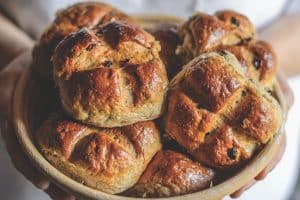Easter wouldn’t be the same without hot cross buns. Their history can be traced back to the Hertfordshire countryside, where an old mill still bakes buns to an ancient recipe. Our guide looks at the history of the hot cross bun and why they are eaten at Easter.

Hot cross buns are traditionally eaten over the Easter religious Christian holiday to symbolise the crucifixion of Jesus on Good Friday on the cross.
If medieval monk Thomas Rocliffe were alive today, he might stop and say a prayer for forgiveness when he reached the hot-cross bun aisle of a supermarket or high-street bakery.
Sold all year round, these sticky fruit buns now come in an assortment of flavours, from chocolate and caramel to orange and cranberry. There are ‘luxury’, ‘very berry’ and ‘extra fruity’ versions. There are even buns filled with fudge, a sickly notion that might have Brother Rocliffe fleeing back to the safety of St Albans Abbey.
What are hot cross buns?
Hot cross buns are a baked sweet, spiced bread which traditionally contain raisins. These are commonly eaten toasted with butter.
History of the hot cross bun
Who invented the hot cross bun?
Thomas Rocliffe, a 14th-century monk, is widely credited as making the very first hot cross bun – and given the simplicity of his medieval recipe, he may well have disapproved of later embellishments to his original creation.
Although the Ancient Greeks, Romans and Saxons all baked a type of bun to mark the changing seasons, it was Brother Rocliffe who made the Alban Bun in 1361.
A sweet, fruity bake bearing a cross on top, the buns were given to the local poor on Good Friday. This Easter treat so pleased the recipients that word soon spread, and efforts were made across the country to imitate these cakes. By the 19th century, hot cross buns were commonly eaten on Good Friday to mark the end of Lent.
What is the difference between a hot cross bun and an Alban bun?
In looks, the Alban bun differs slightly from its successor, the hot cross bun, as the cross – representing, of course, the crucifixion – is cut into the top of the bun with a knife, rather than being piped on with flour paste. Although the original recipe of the Alban bun remains a closely guarded secret, the main ingredients are simply flour, eggs, yeast, currants and spices.
Today, Alban buns are made by local bakery Redbournbury Watermill, which sticks to Brother Rocliffe’s original recipe. But they’re limited edition: the mill only produces its Alban buns and hot cross buns during Lent and Holy Week.
“We feel it’s important to respect these traditions,” says master baker at Redbournbury Steven Mansbridge. “We still bake the Alban buns for the cathedral using their secret recipe. It retains a special link between the cathedral and the mill. The mill was once owned by the cathedral, so it’s wonderful to have restored this relationship.”
Hot cross buns at Redbournbury Mill
Redbournbury Mill is set in an idyllic spot surrounded by water meadows, two miles north of St Albans and close to the Roman road now called Watling Street.
With the River Ver gently flowing past, the area is a haven for wildlife, including kingfishers, egrets, water voles and trout. A mill on this site was recorded in the Domesday Book of 1086 when it belonged to St Albans Abbey; later, during the dissolution of the monasteries, it became part of the Crown Estate.
For nearly 150 years, the mill was operated by tenant millers the Hawkins family, the last of whom was Ivy Hawkins. Known as “the only lady miller in England”, Ivy lived in the mill from the 1950s until 1985, when she left aged 89.
Bought in 1985 by its present owners the James family, the mill and house were devastated by fire two years later. It took 13 years of fundraising and a grant from English Heritage to restore it.
The mill’s original millstones were destroyed in the fire, and the waterwheel badly damaged by falling masonry. Luckily, the owners found a nearby mill that was being converted into offices and were able to use its 100-year-old millstones to replace them. Volunteers repaired the waterwheel 10 years ago and it now runs whenever there’s sufficient water in the river.
Around 1890, the mill was fitted with a steam engine – necessary because pumping stations along the valley had been taking water for the growing population of villages upstream, and there was little left for the river. In 1915 during the First Word War, the steam engine was requisitioned and melted down for munitions. When the James family took over, they found an old oil engine in pieces and volunteers spent 18 months restoring it. It now generates electricity to power the mill when river levels are low.
The mill produces 50 tonnes of flour a year in the traditional manner, grinding grain between horizontal millstones. Most of
this is wheat flour, but rye and spelt are becoming increasingly popular. Much of the grain comes from neighbouring farm, Hammonds End in Harpenden, but 2019’s harvest was poor, so this year the mill will have to source grain from further afield.
The mill is entirely run by volunteers who only mill flour at weekends. During the week, other volunteers hoist grain and flour to the top of the mill, screen wholemeal flour to make white flour, bag the flour and carry out vital maintenance.
Head miller Justin James says: “It’s lovely for children in particular to be able to visit the mill, see the grain being ground and then watch it being baked in our bakery. It’s a perfect example of ‘from crop to crust’.”
(Article source: Countryfile)

